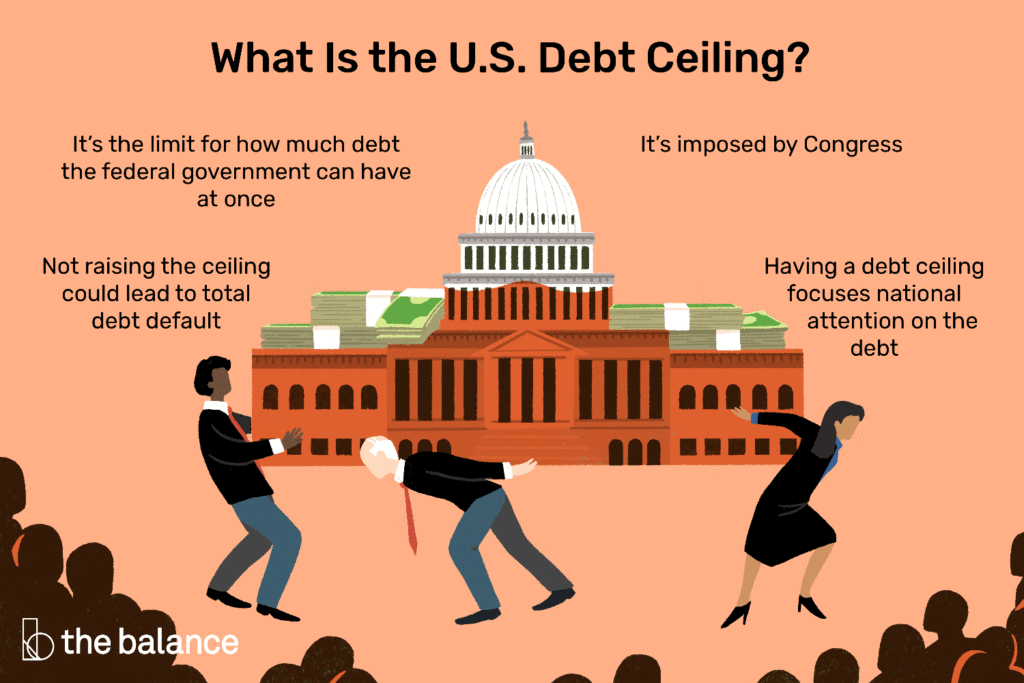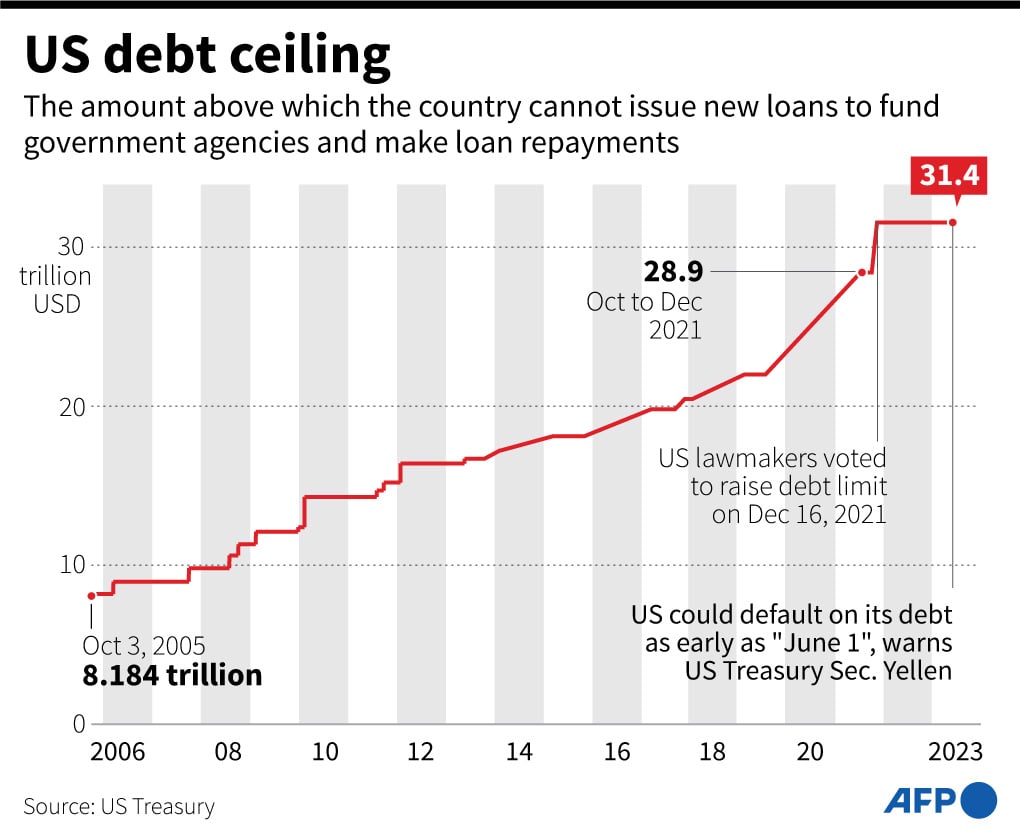The recent US debt deal has set the stage for a potentially transformative event in the financial world. As the United States grapples with its US Debt Ceiling and strives to maintain financial stability, the impact on the global market has become a topic of intense speculation and intrigue.
But what does this all mean for the world of cryptocurrencies? Why should digital asset enthusiasts and investors pay attention to the debt ceiling drama unfolding in Washington? The answer lies in the unique nature of cryptocurrencies, their decentralized nature, and their ability to provide an alternative financial system outside the control of traditional institutions.
Could this debt deal serve as the spark that ignites a cryptocurrency revolution? In this blog post, we will delve into the intricacies of the US debt ceiling, explore the advantages and disadvantages associated with it, and discuss its potential implications for the broader crypto market.
What is US Debt Ceiling?
The debt ceiling refers to the legal limit imposed on the amount of debt that the US government can accumulate to finance its operations. It is a statutory restriction established by Congress to control the government’s borrowing capacity. The purpose of the debt ceiling is to maintain a check on government spending and ensure fiscal responsibility.
The concept of the debt ceiling dates back to the Second Liberty Bond Act of 1917. That authorized the US Treasury to issue bonds to finance World War I. Initially, there was no specific limit on the amount of debt the government could accumulate. However, as concerns grew about the potential for excessive borrowing and its impact on the economy, Congress introduced the debt ceiling mechanism.
The debt ceiling sets a cap on the total amount of money that the US government is authorized to borrow. It represents the maximum level of outstanding debt that the government can have at any given time. Once the debt reaches the predetermined limit, the Treasury Department is prohibited from issuing new debt or borrowing additional funds. Unless Congress approves an increase in the debt ceiling.
However, it is important to note that the debt ceiling does not directly address the underlying causes of government debt, such as budget deficits and spending commitments. It is primarily a mechanism to control the government’s borrowing capacity. And it also ensures that Congress is involved in making decisions regarding increases in the debt limit.
Meanwhile, in the past few days, the debt ceiling has been a subject of intense debate and political maneuvering. Failure to raise the debt ceiling in a timely manner can have serious consequences. It can lead to a government shutdown, delayed payments to individuals and businesses, potential credit rating downgrades, and increased market volatility.
Advantages & Disadvantages of Debt Ceiling
Implementing a debt ceiling is practical because it allows the United States Treasury to quickly issue bonds without requiring Congress to approve it each and every time the federal government wants to raise money—a time-consuming process.
However, the debt ceiling has both advantages and disadvantages. So, let’s delve deeper into these aspects to gain a better understanding:
Advantages:
- Fiscal Discipline: One of the key advantages of the debt ceiling is that it serves as a mechanism to control government spending. By imposing a limit on the amount of debt the government can accumulate, it forces policymakers to evaluate and prioritize budgetary decisions.
- Prevents Excessive Borrowing: The debt ceiling acts as a check on the potential for unlimited borrowing by the government. It ensures that the government must seek approval from Congress to borrow beyond a certain threshold. Thereby preventing the accumulation of unmanageable debt burdens.
- Checks on Government Power: The debt ceiling plays a vital role in ensuring oversight and accountability of the government’s financial actions. It requires policymakers to engage in discussions and negotiations when the debt ceiling is reached. This promotes transparency and public discourse.
Disadvantages:
- Market Volatility and Investor Confidence: The uncertainty surrounding the debt ceiling discussions can create market volatility and negatively impact investor confidence. As the deadline for raising the debt ceiling approaches, there is often increased market uncertainty. That can lead to potential fluctuations in stock prices, bond yields, and currency values.
- Potential for Government Shutdowns: In some cases, political standoffs over raising the debt ceiling have resulted in government shutdowns. When the government lacks the authority to borrow beyond the debt ceiling, it may face difficulties in meeting its financial obligations.
- Credit Rating Downgrades: Failure to raise the debt ceiling or prolonged debates over the issue can lead to credit rating downgrades. Credit rating agencies assess a country’s creditworthiness, and prolonged uncertainty or a potential default can undermine the country’s credit rating.
- Potential for Political Manipulation: The debt ceiling can be used as a political tool, leading to partisan disputes and short-term policy decisions. Such political manipulation can hamper long-term economic planning and stability.
In short, balancing the benefits and drawbacks of the debt ceiling is crucial to ensure responsible fiscal management. That can help minimize the negative impacts on the economy and financial markets.
Why US Debt Crisis Keep on Rising?
The United States has been grappling with a persistent trend of rising debt crises. Understanding the reasons behind this ongoing issue is crucial for comprehending the broader implications. And potential impacts on the cryptocurrency market.
- Growing Budget Deficits: One of the primary factors contributing to the rising US debt crisis is the persistent budget deficits. When the government spends more than it collects in revenue, it needs to borrow money to bridge the gap. Over time, these deficits accumulate and contribute to the overall debt burden.
- Entitlement Programs: Another significant contributor to the rising US debt is the increasing cost of entitlement programs, such as Social Security, Medicare, and Medicaid. As the population ages and healthcare costs continue to rise, the financial burden of these programs becomes more substantial.
- Economic Stimulus and Bailouts: During times of economic recession or crisis, the US government often implements stimulus measures. And it also provides bailouts to stabilize the economy and financial markets. While these interventions are necessary to prevent deeper economic downturns, they come at a cost.
- Interest on Debt: The interest payments on the accumulated debt represent a significant and growing portion of the federal budget. As the debt increases, so does the interest expense. These interest payments further strain the government’s finances. That can limit the resources available for other important initiatives and investments.
- Political Challenges: The US debt crises also stem from political challenges associated with addressing the issue effectively. Raising the debt ceiling or implementing measures to reduce deficits often becomes a contentious political debate.
Addressing this issue requires a multifaceted approach that promotes fiscal discipline, structural reforms, economic growth, and bipartisan collaboration. As the US continues to grapple with its debt challenges, the implications for the broader cryptocurrency market remain significant. That can shape the landscape for investors and financial stability.
About the Recent US Debt Deal
The recent US debt deal, prompted by the need to raise the debt ceiling, has garnered significant attention and speculation within the cryptocurrency community. The deal, reached after intense negotiations between political parties, averted a potential default by allowing the US government to continue borrowing funds to meet its financial obligations.

However, the terms and conditions of the debt deal have broader implications that could potentially ignite a cryptocurrency revolution. The agreement includes provisions for budgetary adjustments, spending cuts, and potential revenue enhancements. These measures aim to address the country’s fiscal challenges and ensure a sustainable path forward.
By implementing budgetary adjustments, the government aims to reduce its reliance on borrowing and curb the growth of the national debt. This commitment to fiscal responsibility may instill confidence in investors and markets. That can potentially boost the overall sentiment toward cryptocurrencies.
Furthermore, the debt deal signifies a broader recognition of the need to address the long-term economic challenges facing the United States. The negotiations and compromises made during this process highlight the complexities and vulnerabilities of the existing financial system. As a result, it could prompt further examination and evaluation of alternative financial solutions, such as cryptocurrencies.
US Debt Deal Implications on the Broader Crypto Market
The US debt deal has the potential to ignite a cryptocurrency revolution for several reasons. First, the resolution of the debt ceiling crisis could provide a sense of stability and restore investor confidence in the US economy. Investors seeking alternative assets that are not directly tied to traditional financial systems often benefit from uncertain economic conditions. With cryptocurrencies like Bitcoin being a prime example.
Second, the debt deal may lead to increased inflationary pressures as the government continues to borrow and spend. Inflation can erode the value of traditional fiat currencies. That can make cryptocurrencies an attractive store of value for investors seeking protection against currency devaluation.
Furthermore, the debt deal may prompt further scrutiny of the existing financial system, highlighting its vulnerabilities and limitations. This increased awareness could drive more individuals and institutions to explore and adopt cryptocurrencies as an alternative form of money and investment.
Conclusion
While the recent US debt deal has implications for the broader financial markets, it also has the potential to ignite a cryptocurrency revolution. The stability and confidence restored by the resolution of the debt ceiling crisis, coupled with inflationary pressures and increased scrutiny of traditional financial systems, could drive interest and investment in cryptocurrencies.
As the world continues to navigate economic uncertainties, cryptocurrencies may emerge as a viable alternative for investors seeking financial security and autonomy.
To know more about the US Debt Ceiling, go check out SunCrypto Academy.
Disclaimer: Crypto products and NFTs are unregulated and can be highly risky. There may be no regulatory recourse for any loss from such transactions. All content provided is for informational purposes only, and shall not be relied upon as financial/investment advice. Opinions shared, if any, are only shared for information and education purposes. Although the best efforts have been made to ensure all information is accurate and up to date, occasionally unintended errors or misprints may occur. We recommend you to please do your own research or consult an expert before making any investment decision. You may write to us at [email protected].








